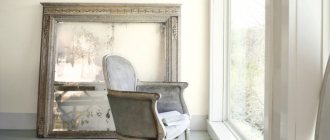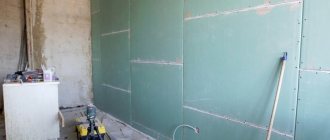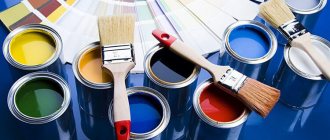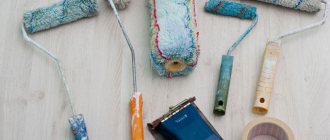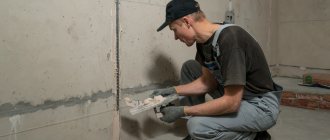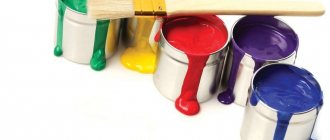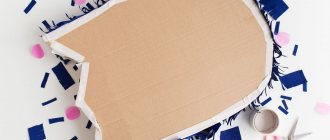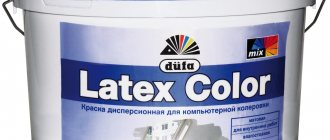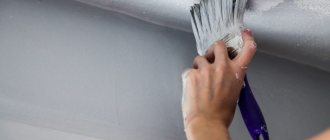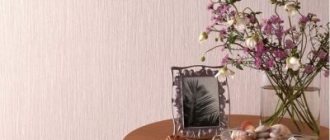The building materials market is constantly updated with all sorts of new products that make life easier for craftsmen and allow them to complete the work faster and with better quality. Wear-resistant rubber paint is one of these new products. In a short time it has gained popularity and is successfully used both indoors and outdoors.
Using this material you can create a durable and reliable waterproof layer on almost any surface. It is suitable for application on wood, metal, brick, stone, concrete, etc. It is also worth mentioning the excellent decorative effect.
What is wear-resistant rubberized paint?
Rubber paint on wood is one of the types of water-dispersion compositions.
It is used for external and internal painting. Rubber paint on wood is one of the types of water-dispersion compositions. It is used for external and internal painting. It is used by professionals and beginners alike. This became possible due to the special characteristics, high performance parameters and ease of application.
Compound
When applied to a surface, wear-resistant wood paint for exterior work forms an elastic film that resembles rubber in appearance and characteristics.
The color is matte, and the external coating looks like soft silk. This effect is due to the presence of the following components:
- Water is used as a solvent. It contains no more than 5%.
- The compositions are made not on the basis of pure latex, but with the inclusion of acrylate latex polymer. Thanks to this, the applied layer of paint is elastic and durable.
- Coalescent additives are responsible for converting the coloring material into a film when applied to wood.
- Antifreeze imparts resistance to negative temperatures, so wear-resistant paint can be used both indoors and outdoors.
- Fire retardants give compositions fire resistance.
- Preservatives are responsible for protecting wood from mold and fungi.
- The pigment gives rubber paint for wood the desired shade.
The water-acrylic base has made the paint popular because it is safe. In addition, innovative formulations belong to the middle price category.
Properties and characteristics
The key property that separates rubber materials from other exterior paints is elasticity. It guarantees perfect coverage and eliminates peeling and cracking during use of the structure. The compositions are also characterized by good vapor permeability, as a result the wood “breathes”, which eliminates damage to the wood and loss of properties. When applied, the surface color is more saturated than other types of materials.
Main types
Manufacturers produce rubber paints for various types of surfaces: concrete, brick, wood, etc. The form of release also differs. There are options available on the market for brush and roller application. It is possible to purchase latex coloring material in an aerosol can. There are universal paints. There are also separate ones for interior and exterior work. They are more suitable for painting indoors and outdoors.
Where is it used?
High quality characteristics have led to a wide range of uses of rubber paint. It is used not only for wooden structures, but also for metal, concrete and brick surfaces. If we talk about wood, then they paint with rubberized compounds:
- facades;
- walls, ceiling, windows, floors indoors;
- furniture and decorative elements;
- stairs and fences;
- cabins and wells.
In general, any wooden structure can be painted with wear-resistant latex paint. This will give it durability and make it look unsurpassed.
Advantages and disadvantages
Users choose rubber paints because they have the following advantages:
- High elasticity. This property allows you to create an ideal surface even on walls with minor defects and cracks.
- Hydrophobicity prevents moisture from entering the wood, therefore preserving it from damage.
- Vapor permeability prevents rotting and decomposition of wood.
- Increased wear resistance. The elastic surface does not slip or wear out, which extends its service life and allows it to remain attractive for a long time.
- The environmental friendliness of the composition allows it to be applied indoors, even public. The paints do not emit harmful substances and are odorless.
- Easy to care for. Surfaces coated with latex paints are easy to clean using detergents.
- Resistance to ultraviolet radiation. The bright color does not fade under the influence of direct sunlight.
- Resistance to low and high temperatures. The range of application of paints is from -60 to + 100°C.
- Long period of use. The paint has a service life of at least 10 years.
With a long list of advantages, rubber compounds have fewer disadvantages:
- Possibility of painting only in matte color. In this case, the problem is solved by applying a varnish coating to the rubberized surface.
- Temperature limitation for application. It is not recommended to paint wood at sub-zero temperatures.
High performance characteristics have made these new generation paints very popular. Manufacturers have launched the production of latex coloring agents. It is important to select proven products to get the desired effect.
Scope and purpose
Rubber paints are convenient because they come in the form of sprays, allowing you to paint small areas
“Elastic paint”, due to its characteristics and ease of use, has gained popularity not only for painting wood. Its ability to fill seams and cracks has made it indispensable for painting facades and roofs. (See also the article Facade paint for wood: features.)
Such a characteristic as water resistance makes it possible to use paint as a waterproofing material for artificial ponds and swimming pools.
The water resistance of rubber paints has made them almost indispensable when arranging home pools.
Painting components and cars, applying road markings, covering gyms, courts, stadiums and playgrounds, painting wooden, metal and concrete fences, terraces and balcony floors - all this can be done with rubber paint.
Manufacturers
Many time-tested companies have recently begun to produce latex paints with
using innovative technologies. Among the popular brands are:
- Balticolor with the product Super Decor Rubber, a market leader in sales due to its high performance and reasonable cost.
- Tikkurila offers latex compounds in a wide range of colors.
- Prosvet produces materials with high hiding power and elasticity.
- Caparol offers more than 20 types of products in the latex paint category. Produces the most environmentally friendly products.
- Farbex produces universal compositions for outdoor use with various types of surface.
- Dali makes products with an antifungal effect. The paints adhere perfectly to the surface and mask defects.
There are many other manufacturers offering products for painting wood based on acrylate latex. Before purchasing, you should carefully study consumer reviews to make the right choice.
Rules for painting with rubber paint
The final result is influenced not only by the quality of the paint and varnish products, but also by compliance with the technology of preparing the surface for painting and the painting itself.
Tool
When carrying out external work, a brush, roller or spray is used for painting. Rubber materials in aerosol packaging are used when painting small wooden surfaces. The compositions are sold in already diluted form, so a container for dilution is not required. A finned bath is also needed to remove excess dye.
Preparatory work
As when applying other types of coloring materials, you will need to prepare the wood:
- remove old coating;
- clean from fungus, mold, efflorescence;
- sand (small defects can be left - rubber paint will hide them);
- remove dust and dirt;
- prime.
After carrying out the described procedures, the tree is ready for external painting.
Painting
The surface is covered with a coloring composition in 2-3 layers. Between each application, wait until the previous coating has dried. On average, 2-3 hours are enough for polymerization. The composition is stirred periodically so that no sediment forms and the coating lays down evenly.
General recommendations for work
The photo shows the process of applying paint using a spray gun, which allows you to get a uniform coating with minimal material consumption
- If you have to work with untreated wood, be sure to sand the product and cover it with a layer of antiseptic. Metal surfaces are cleaned and degreased, concrete surfaces are primed with a universal primer or hardening impregnation. Glossy hard surfaces require pre-painting with oil or alkyd paints, alternatively washing with sodium phosphate solution or soda.
- Control painting makes it possible to evaluate the thickness of the paint, the brightness of the color and the exact drying period.
- Manufacturers do not recommend painting in high air humidity (>80%), windy weather, or in direct sunlight.
When carrying out work with your own hands, take care of reliable protection and safety measures
- Rubber paint for wooden floors is applied not in one thick layer, but in a couple of thin ones. This allows the coating to become wear-resistant. Please note that the interval between applications should be at least 1-2 hours.
Advice! You can wash the floor with cleaning products only after a week has passed after painting. The process of polymerization and gaining full strength takes several days.
Application technology and features
- Clean the surface to be painted from dust, dirt, rust and oil contaminants.
- Rinse with water and let dry completely.
- Mix the contents of the paint container thoroughly and add water if necessary.
- Using a spray gun, roller or brush, apply the first coat of paint.
- Apply a second coat after two hours.
Note! Depending on the method of application and the porosity of the surface to be painted, paint consumption can vary from 100 to 200 g/m².
Tips and tricks
To get the desired result, follow the following recommendations from professionals:
- Carry out external work at a temperature of at least 5°C.
- Paint dry wood. The humidity level should not exceed 20%.
- Prime the wood before painting, which will improve protection and reduce paint consumption.
Latex materials are easy to apply, so if you follow professional advice, you will be able to achieve the ideal effect of exterior painting with your own hands.
Recommendations for selection
When purchasing rubber paint, pay attention to its purpose. A number of dyes have a narrow focus. For example, rubber-based paint for wood contains antiseptic additives, and a product for concrete floors contains a high content of acrylic latex. For roofing work, an important parameter is resistance to aggressive environmental influences and temperature changes.
An extremely important point is correct storage and compliance with temperature conditions.
Note! The shelf life is also important, especially if the work will be carried out six months after purchasing the product.
The instructions for storage and transportation recommend that paint be stored in a room with a temperature of at least 0 °C; only short-term exposure to cold (up to -20 °C) is allowed. If the elastic enamel freezes, it is kept for 24 hours at a temperature of +25 °C.
